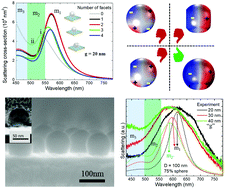A single bottom facet outperforms random multifacets in a nanoparticle-on-metallic-mirror system†
Abstract
Highly efficient nanoparticle-on-metallic-mirror (NPOM) systems with a large gap size exhibiting good plasmonic enhancement are desirable for numerous practical applications. Careful, explicit design optimization strategies are required for preparing NPOMs and it is especially important in utilizing spherical nanoparticles. In this work, a new design blueprint for evaluating the role of random facets in spherical nanoparticles was investigated in detail to realize optimal NPOMs. We found that a precise single facet positioned at the nanoparticle's cavity outperformed multiple random facets due to the gap mode contribution. Differences and changes in the plasmonic modes were interpreted with the help of three-dimensional surface charge density mappings. A high-performance, single, bottom-faceted NPOM device with a large gap size (example 20 nm) was realized having 80–50% facet design, resulting in excellent gap mode enhancement. We succeeded in fabricating single bottom-faceted NPOMs (the non-facet region had a smooth spherical surface) with a large-scale unidirectionality (2 cm × 1.5 cm). Simulations and experimental characterizations of these components displayed excellent agreement. Our highly efficient NPOM design with a large gap size(s) enables interesting practical applications in the field of quantum emitters, energy devices, fuel generation and plasmon chemistry.



 Please wait while we load your content...
Please wait while we load your content...